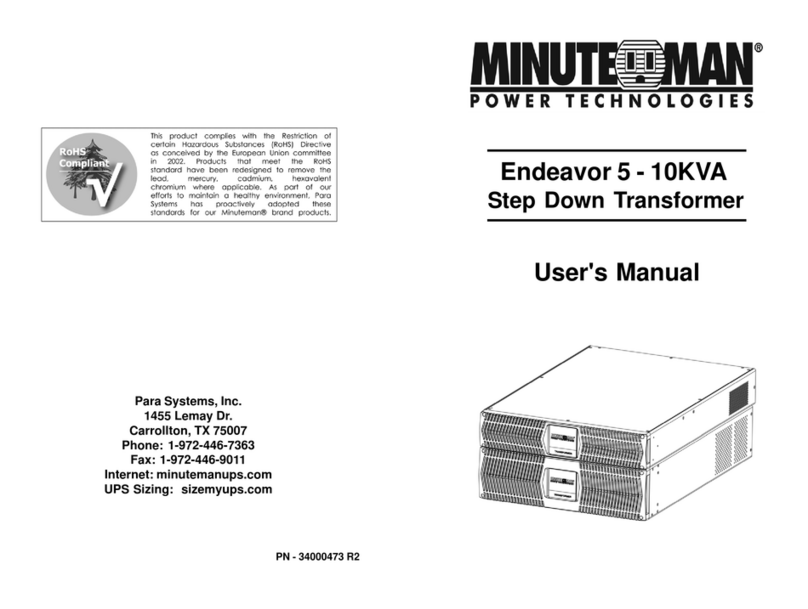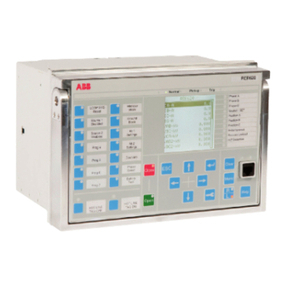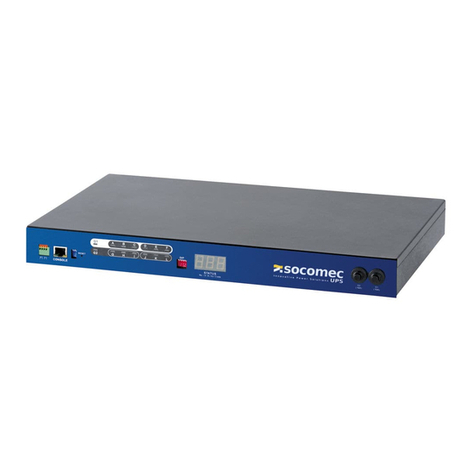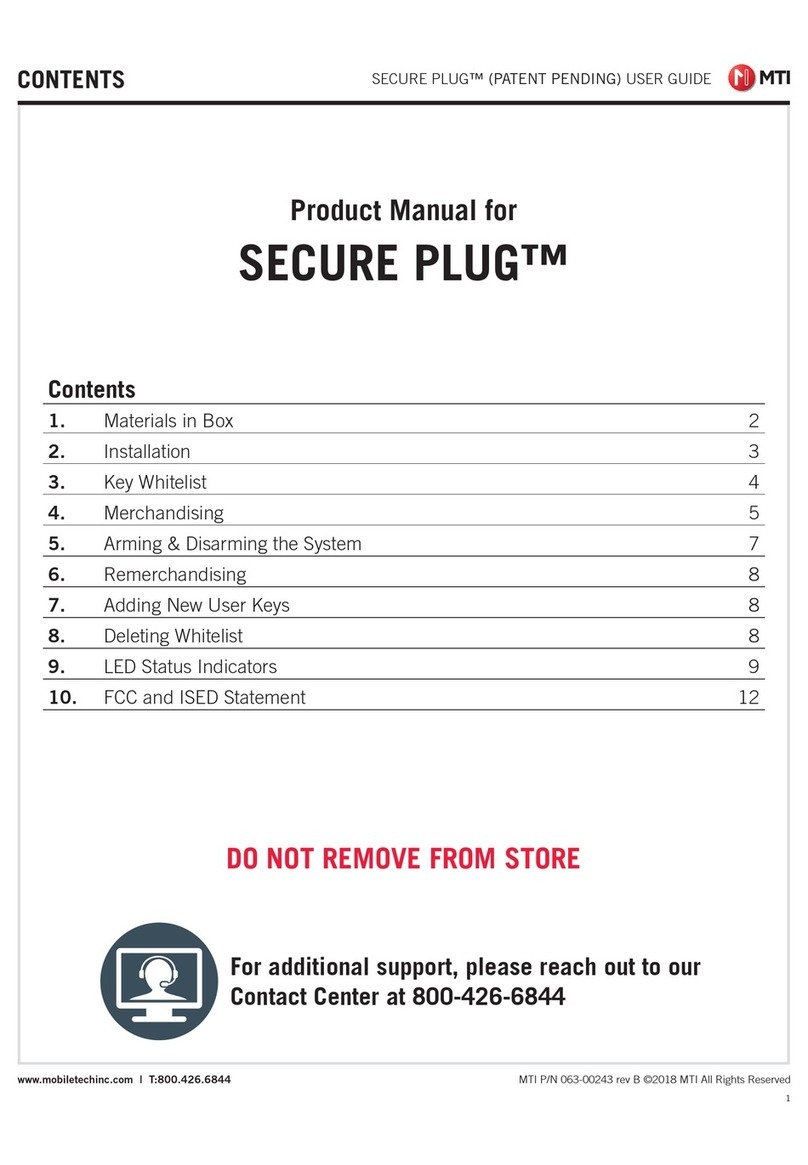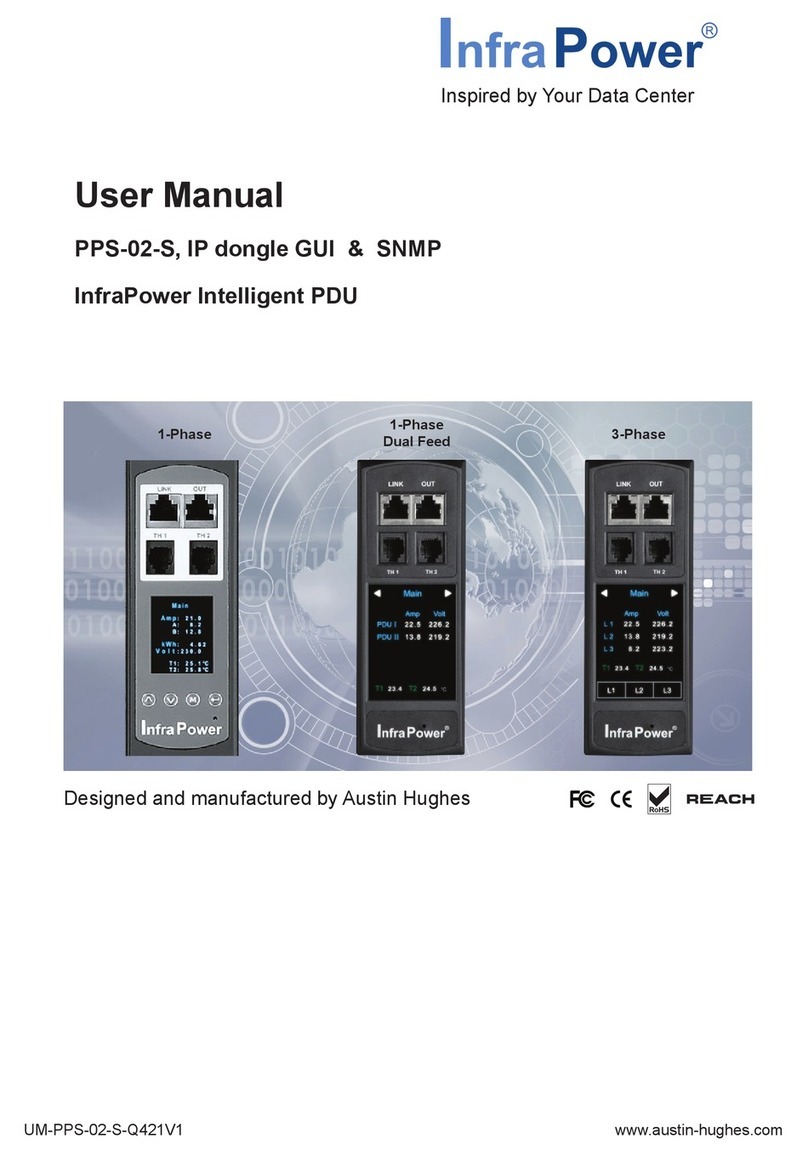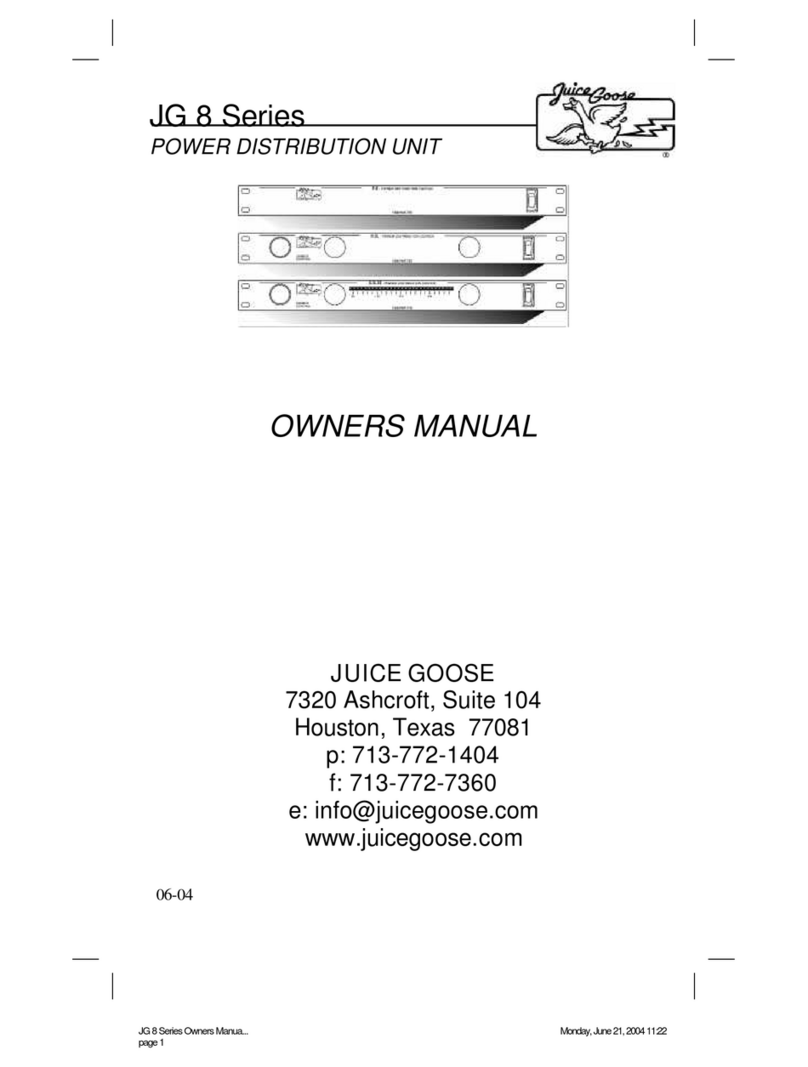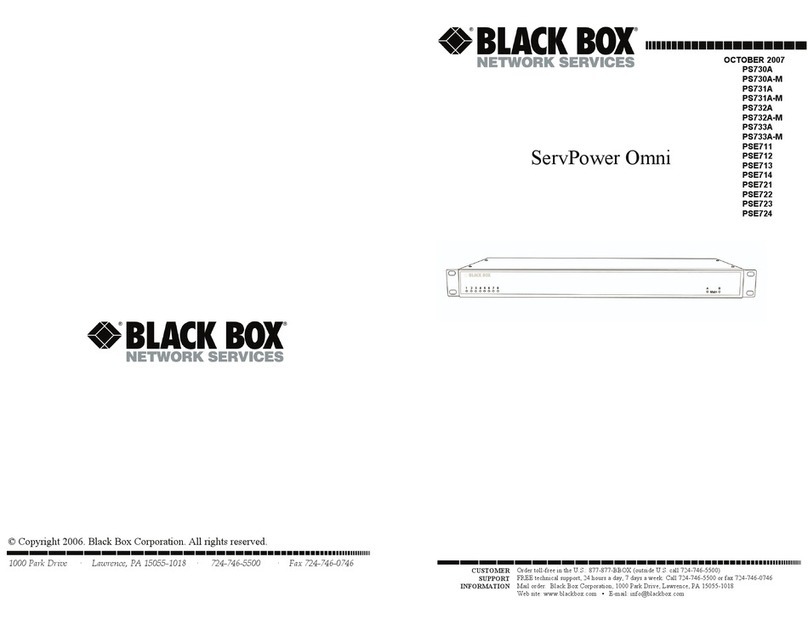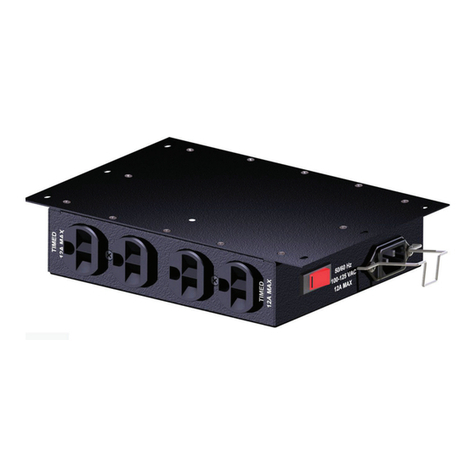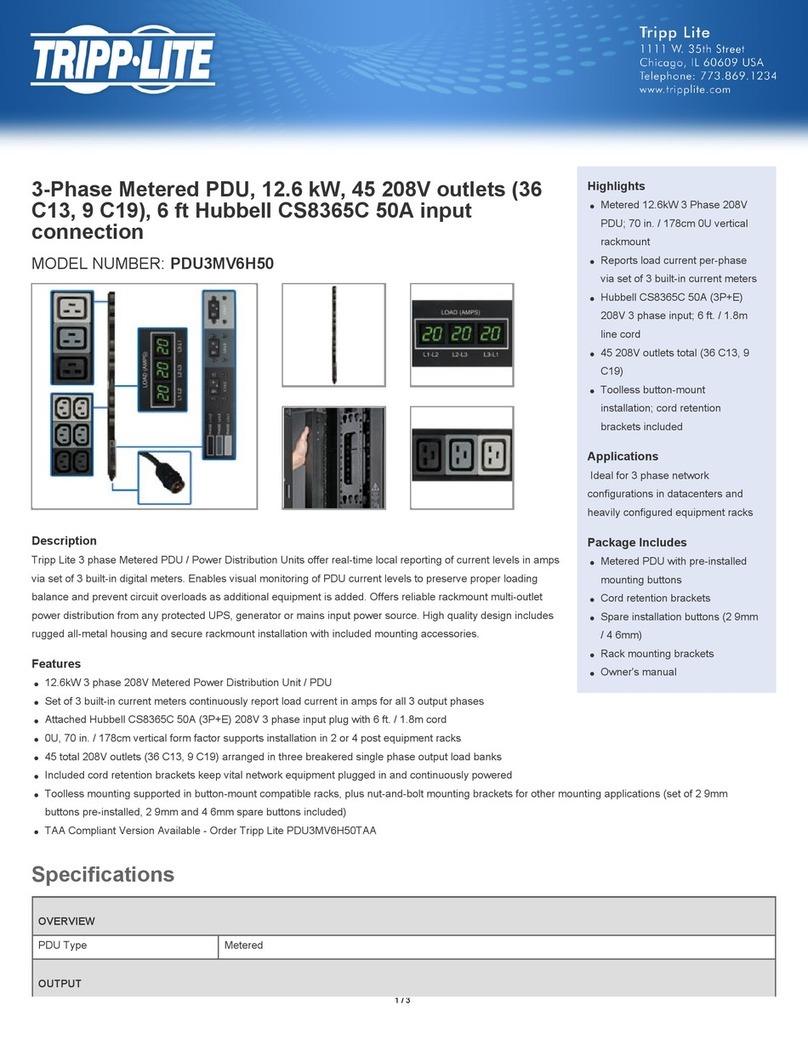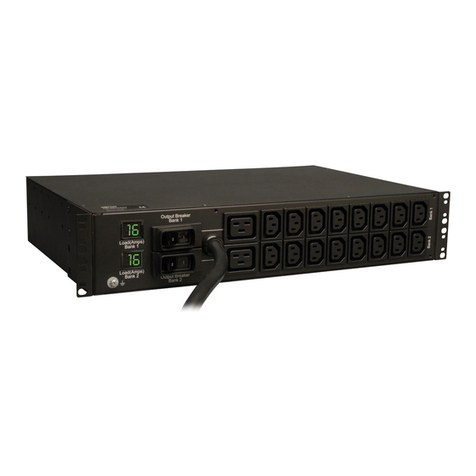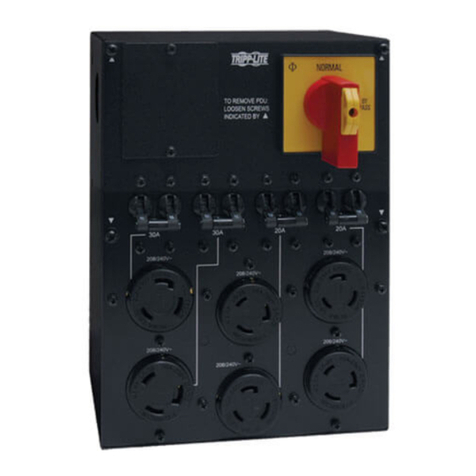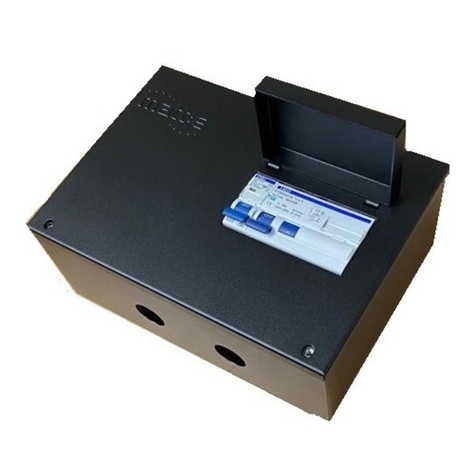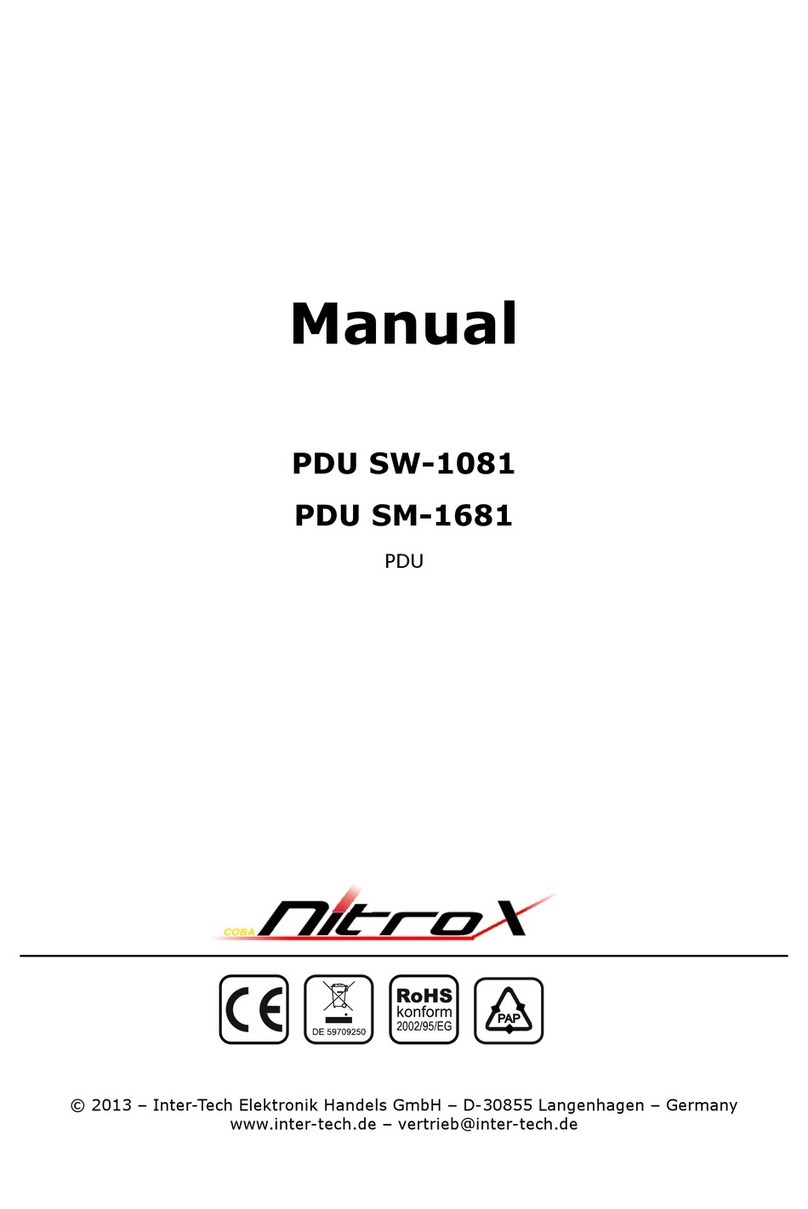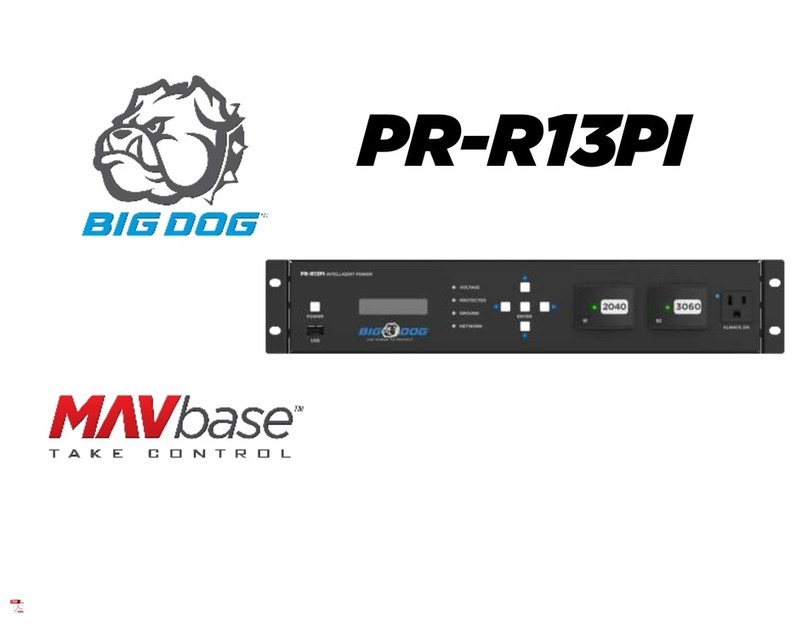GE Multilin DTP-B User manual

GE
Multilin
215 Anderson Avenue
L6E 1B3 Markham, ON -CANADA
Tel: (905) 294 6222 Fax: (905) 294 8512
E-mail: [email protected]
Internet: www.GEMultilin.com
Copyright © 2005 GE Multilin
DTP-B
Digital Transformer Protection
Instruction manual
GEK-106243E
GE Multilin
Avda. Pinoa, 10
48170 Zamudio SPAIN
Tel: +34 94 485 88 00 Fax: +34 94 485 88 45
E-mail: [email protected]
gGE Consumer & Industrial
Multilin

TABLE OF CONTENTS
GEK-106243E106243E DTP Digital Transformer Protection i
1. GENERAL DESCRIPTION 1-1
2. APPLICATION 2-1
2.1 DESCRIPTION 2-1
2.2 CALCULATIONS 2-3
2.2.1 METHOD 2-3
2.2.2 PHASE SHIFT COMPENSATION 2-3
2.2.3 CALCULATION OF CT TRANSFORMATION RATIOS AND RELAY TAPS 2-3
2.2.4 PERCENTAGE RESTRAINT SETTING 2-5
2.3 TRANSFORMER CALCULATIONS (FIGURE 6) 2-6
2.3.1 1ST ITERATION. CALCULATIONS REFERRED TO THE TRANSFORMER SHOWN IN
FIGURE 6 2-6
2.3.2 2ND ITERATION. NEW CT RATIOS FOR WINDINGS B AND C 2-9
2.3.3 PERCENTAGE RESTRAINT SETTING K1(FIGURE 9) 2-9
2.3.4 PERCENTAGE RESTRAINT SETTING K2(FIGURE 9) 2-10
2.3.5 CT CONFIGURATION SETTING 2-10
3. OPERATING PRINCIPLES 3-1
3.1 DESCRIPTION OF THE GENERAL OPERATING PRINCIPLE 3-1
3.2 MEASUREMENT ALGORITHMS 3-2
3.2.1 DIFFERENTIAL CURRENT 3-2
3.2.2 THROUGH CURRENT 3-3
3.2.3 HARMONIC RESTRAINT 3-3
3.2.4 INTERNAL PHASE SHIFT MATCHING 3-3
3.3 INTERNAL STATES 3-4
4. FUNCTIONS DESCRIPTION 4-1
4.1 PROTECTION FUNCTIONS 4-1
4.2 MONITORING AND REGISTERING FUNCTIONS 4-1
4.2.1 MEASUREMENT 4-1
4.2.2 LED INDICATORS 4-1
4.2.3 SELF-CHECKING FUNCTIONS 4-2
4.3 ANALYSIS FUNCTIONS 4-3
4.3.1 EVENT RECORDER 4-3
4.3.2 OSCILLOGRAPHY RECORDER 4-3
4.4 SETTINGS TABLES 4-4
4.5 INPUTS AND OUTPUTS 4-5
4.5.1 DIGITAL INPUTS 4-5
4.5.2 OUTPUTS 4-5
4.6 HUMAN-MACHINE INTERFACE (MMI). 4-6
4.7 REMOTE COMMUNICATIONS 4-6
5. SETTINGS 5-1

TABLE OF CONTENTS
ii DTP-B Digital Transformer Protection GEK-106243E
6. UNIT CONFIGURATION 6-1
6.1 INPUTS CONFIGURATION 6-1
6.2 OUTPUTS CONFIGURATION 6-2
6.3 LEDS CONFIGURATION 6-2
7. TECHNICAL CHARACTERISTICS 7-1
7.1 MODEL LIST 7-1
7.2 TECHNICAL CHARACTERISTICS 7-2
7.2.1 MECHANICAL 7-2
7.2.2 ELECTRICAL CHARACTERISTICS 7-2
7.2.3 COMMUNICATIONS 7-3
7.2.4 STANDARDS 7-4
8. HARDWARE DESCRIPTION 8-1
8.1 PHYSICAL DESCRIPTION 8-1
8.1.1 CASE 8-1
8.1.2 ELECTRICAL CONNECTIONS 8-1
8.1.3 INTERNAL CONSTRUCTION 8-2
8.1.4 IDENTIFICATION 8-3
8.1.5 MAGNETIC MODULE 8-3
8.1.6 PROTECTION CPU PROCESSING BOARD 8-4
8.1.7 COMMUNICATIONS CPU MODULE 8-4
8.1.8 INPUTS/OUTPUTS MODULE. 8-4
8.1.9 POWER SUPPLY 8-5
8.1.10SAMPLE & HOLD MODULE 8-5
8.2 RECEPTION, HANDLING & STORAGE 8-6
8.3 INSTALLATION 8-6
9. ACCEPTANCE TESTS 9-1
9.1 CONNECTIONS 9-1
9.2 VISUAL INSPECTION 9-1
9.3 INSULATION TESTS 9-1
9.4 POWER SUPPLY 9-2
9.5 MEASUREMENT CHECK 9-2
9.6 DIGITAL INPUTS CHECKING 9-3
9.7 OUTPUTS CHECKING 9-3
9.7.1 TRIP OUTPUTS CHECKING. 9-3
9.7.2 ALARM OUTPUTS CHECKING. 9-3
9.7.3 CONFIGURABLE OUTPUTS CHECKING. 9-3
9.8 COMMUNICATION PORTS CHECKING 9-4
9.9 KEYPAD, DISPLAY, AND LEDS CHECKING. 9-4
9.10 OPERATIONS 9-5
9.10.1TIME SETTING. 9-5

TABLE OF CONTENTS
GEK-106243E106243E DTP Digital Transformer Protection iii
9.10.2COMMUNICATIONS TRIGGER. 9-5
9.11 PERCENTAGE RESTRAINT CHECKING 9-5
9.12 HARMONIC RESTRAINT CHECKING 9-5
9.13 INSTANTANEOUS FUNCTION CHECKING 9-6
10. INSTALLATION AND MAINTENANCE 10-1
10.1 INSTALLATION 10-1
10.2 CONNECTION TO GROUND AND SUPPRESSION OF DISTURBANCES 10-1
10.3 MAINTENANCE 10-1
11. KEYBOARD AND DISPLAY 11-1
11.1 MENU TREE 11-2
11.2 SETTINGS GROUP 11-4
11.3 INFORMATION GROUP 11-8
11.4 OPERATIONS GROUP 11-10
11.5 SINGLE KEY OPERATION 11-11
11.6 CONFIGURATION MENU 11-12
12. FIGURES 12-1

TABLE OF CONTENTS
iv DTP-B Digital Transformer Protection GEK-106243E
LIST OF TABLES
Table I: Internal Communications States
Table II: Internal Protection States
Table III: Settings common to all tables
Table IV: Independent Settings for each table
LIST OF FIGURES
Fig. 1: External connections
Fig. 2: Panel drilling dimensions
Fig. 3: RS-232 Connection
Fig. 4: Dimensions diagram
Fig. 5: Front view
Fig. 6: Sample transformer for the calculation of settings
Fig. 7: Operating principles of the differential protection
Fig. 8: Block diagram of the protection
Fig. 9: Percentage Characteristic

1. GENERAL DESCRIPTION
GEK-106243E DTP Digital Transformer Protection 1-1
1. GENERAL DESCRIPTION
During the last years, new technologies have achieved an important improvement in the concept of function
integration between the different components of electrical systems. There are several reasons for that integration:
• Reduce the investment in new equipment.
• Optimize the use of the existing installations.
• Improve the energy management system.
This function integration not only includes the high and low voltage switchgear protection and control devices,
protection of different elements, signalling and alarms of a substation, but also the monitoring of all elements, the
analysis of the great amount of available information (events, alarms, oscillography, load and demand profiles),
and certainly innovative functions, such as substation maintenance, adaptive protections, etc.
The DTP is a digital relay that provides differential (87) and backup instantaneous (87B) three phase protection
functions for power transformers. Different models of the DTP are available for protecting and monitoring
transformers with two, three, or four windings.
This equipment incorporates the following functions:
a) Protection
• Totally digital three phase differential protection (87) with percentage restraint and harmonic restraint (second
and fifth harmonic).
• Programmable backup differential instantaneous protection (87B).
• Additional dynamic harmonic restraint (innovative function compared to static harmonic restraint)
• Digital filtering of the zero-sequence component of the applied current.
• Internal phase shift compensation system with obtaintion of the currents for each winding and phase, from the
line currents.
b) Monitoring and register
• Line current (module and argument), differential current (fundamental, second and fifth harmonic) and through
RMS current measurement.
• 17 LED indicators (16 of which can be configured by the user).
• Built in self-checking unit.
c) Analysis
• Historical event recorder.
• Oscillography recorder.
• Alarm recorder.

1. GENERAL DESCRIPTION
1-2 DTP-B Digital Transformer Protection GEK-106243E
d) Communication Interfaces
The DTP has three communication ports, one on the front of the relay, and two on the rear. The front port (PORT
1) and one of the rear ports (PORT 3) are RS232, while the other rear port (PORT 2) can be RS232, RS485,
glass or plastic fiber optics.
The following software is associated to the DTP:
• GE-LOCAL Communications Software, allowing the user to monitor and modify the protection settings, alarms,
internal status, etc.
• GE-INTRO Configuration Software, used for the configuration of inputs, outputs, alarms and LED indicators.
• GE-OSC Oscillography Software, for monitoring and analyzing oscillography records.
These software packages are part of GE-NESIS (General Electric NEtwork Substation Integrated System)

2. APPLICATION
GEK-106243E DTP Digital Transformer Protection 2-1
2. APPLICATION
2.1 DESCRIPTION
The current transformer ratios and relay taps must be selected to obtain the maximum sensitivity without risking
relay measurement overflow, thermal overload of the relay or current transformers. Due to the low level of load
presented by the relay, which has a permanent thermal capacity of 4 times In, and a transient capacity of 100 x In,
it is very improbable to cause an overload this way.
Therefore, the current transformer ratios in the various windings of the power transformer should be selected with
the following points in mind:
• The highest sensitivity is obtained by selecting the lowest relay tap and the lowest CT ratio. However, the
lowest CT ratio and the lowest relay tap may not be compatible with some of the following restrictions. Where
a choice is available of increasing either the CT ratio or the relay tap, it is preferable to increase the CT ratio
instead of the relay tap. Since the relay burden is usually smaller than the lead burden, increasing the CT ratio
tends to improve the relative performance of the CTs. This is a result of reducing the maximum secondary
fault current and increasing the accuracy of the CTs.
• The CT secondary current must not exceed the continuous thermal rating of the CT secondary winding.
• The relay current corresponding to the maximum kVA (on a forced-cooled basis) of the power transformer
must not exceed 4 times the nominal current rating of the DTP relay (5 A or 1 A), which is the continuous
thermal capacity of the DTP relay.
• The CT ratios must be high enough so that the secondary currents will not damage the relay under maximum
internal fault conditions. The DTP relay can withstand 100xIn for 1 second, nevertheless, the dynamic limit
current is sensibly higher.
• The relay current corresponding to rated kVA of the power transformer (on a self cooled basis) must not
exceed the relay tap value selected. Otherwise magnetizing inrush current might operate the backup
instantaneous function (87B). If the power transformer does not have a self-cooled rating, the user should
contact the manufacturer for the “equivalent self-cooled rating”.
• The DTP relay’s backup instantaneous function (87B) can be set to operate for differential currents from 4 to
12 times the selected relay tap. If in-service experience results in instantaneous function operation during
magnetizing inrush conditions, such operation can be avoided by changing the setting to a value greater than
8.
• The CT, on its full-ratio or the tap chosen, must be able to supply the relay with a current of 8 times the
selected tap, with an error of less than 20% of the total current. If the current transformers produce an error of
greater than 20% at less than 8 times tap value, the harmonic content of the secondary current may be
sufficient to prevent the differential protection from operating. Since the backup instantaneous function is
activated by the fundamental component and is not affected by the harmonic content of the differential
current, the instantaneous function will operate to produce a relay trip even if appreciable CT saturation
occurs for an internal fault that produces current above the instantaneous function’s recommended pickup
setting of 8 times tap.
• The CT ratios must be selected to provide balanced secondary currents for the case of an external fault.
Since it is rarely possible to match the secondary currents exactly by selection of CT ratios, ratio matching
taps are provided in the relay to match the secondary currents within very narrow margins. When the power
transformer is equipped with Load Tap Changing (LTC) a close match cannot be obtained at all points of the
ratio-changing range. In this case, the secondary currents are matched at the middle of the range and the
relay’s percentage restraint is relied upon to prevent relay operation on the unbalanced current when the LTC
is at the ends of the range.

2. APPLICATION
2-2 DTP-B Digital Transformer Protection GEK-106243E
• In some applications, one or more of the power transformer’s windings may be connected to the power
system via two breakers. An example is a ring bus. In this case, the CT ratios must be selected so that the
secondary windings will not be thermally overload on load current flowing around the ring bus in addition to
the transformer load current. In such cases, it is recommended that each of the two CTs be connected to
separate relay restraint windings to assure adequate restraint for heavy through-fault current flowing around
the ring bus.
• Protecting two parallel transformer banks with one DTP relay is not recommended since the sensitivity will be
reduced. Additionally, if the two banks can be switched independently, there is a possibility of false operation
when the inrush current of one transformer bank provokes a “sympathetic inrush current” into the bank
already energized. In this case, the harmonics tend to flow between the two banks with the possibility that
there will be insufficient harmonics in the relay current to restrain the relay. Should one DTP relay be used to
protect two independently switched parallel transformers, the DTP relay’s harmonic restraint (adjustable from
12% to 50%) may be increased to preclude a misoperation.

2. APPLICATION
GEK-106243E DTP Digital Transformer Protection 2-3
2.2 CALCULATIONS
2.2.1 METHOD
The calculations required to determine the proper relay taps and CT ratios are described below. A sample
calculation, for the transformer shown in Figure 6, is presented.
2.2.2 PHASE SHIFT COMPENSATION
The secondary currents applied to the relay must be in phase if the EXTERNAL COMPENSATION mode is used.
The differential and through currents are obtained directly from the relay input currents, and any required phase
shift compensation or zero-sequence current elimination must be obtained by proper connection (i.e., either wye
or delta) of the current transformers.
In the INTERNAL COMPENSATION mode, phase shift compensation and zero-sequence current elimination are
taken care of in the DTP relay
2.2.3 CALCULATION OF CT TRANSFORMATION RATIOS AND RELAY TAPS
For this calculation, the following steps must be taken:
• For each winding, determine the maximum line current (Ip max.) based on the maximum forced-cooled kVA
rating of the power transformer:
(Maximum transformer kVA)
Ip max= ⎯⎯⎯⎯⎯⎯⎯⎯⎯⎯⎯⎯⎯⎯⎯⎯⎯⎯⎯
√3 x (kV - LL)
• For each winding, determine the rated line current (100%Ip) based on the full self-cooled kVA rating (or the
“equivalent self-cooled rating”) of the power transformer.
(100% transformer kVA)
100% Ip= ⎯⎯⎯⎯⎯⎯⎯⎯⎯⎯⎯⎯⎯⎯⎯⎯⎯⎯⎯
√3 x (kV - LL)
These calculations do not necessarily mean that each winding is going to carry these currents continuously. This
is only a convenient way of calculating the currents in the other windings in proportion to their voltage ratings. This
is the requirement for selecting the relay tap settings so that the relay will not operate for an external fault.
• Select CT ratios so that the secondary current corresponding to Ip max does not exceed the CT secondary
thermal rating. Also, select CT ratios so that the relay currents can be properly matched by means of the relay
taps.
When the DTP is set in INTERNAL COMPENSATION mode, the wye-delta changes imposed by the transformer
time group as detailed in the PHASE SHIFT COMPENSATION section can be carried out by settings in the relay
through the front keypad or the communications program. It is not necessary to perform these changes on the CT
secondaries, which can always be wye connected. In this case, the taps will be chosen on the basis of currents
resulting from the CT’s wye configuration, no matter how the transformer winding is connected (wye or delta). By

2. APPLICATION
2-4 DTP-B Digital Transformer Protection GEK-106243E
means of independent settings we will inform the relay about this connection, so that the DTP will perform
internally the magnitude corrections resulting from changes wye-delta and vice-versa.
• Determine the burden on each CT using the following expressions:
a) For wye connected CTs:
N x e + 2.5 f
Z = B + ⎯⎯⎯⎯⎯⎯⎯ + 2.27 R Ω
1000
b) For delta connected CTs:
N x e + 2.5 f
Z = 2B + ⎯⎯⎯⎯⎯⎯⎯ + 2.27 Ω
1000
where:
B= DTP relay total burden (0.04 Ωapprox.).
N= CT secondary turns
e= CT resistance per turn in milliohms.
f= CT resistance per lead in milliohms.
R= one-way control cable lead resistance (at 75ºC)
The multiplying factors associated with f and R account for two cable leads instead of one, resistance value
increase due to temperature rise, and the resistance of the longest CT leads.
• Determine the CT secondary current for 8 times the tap value:
Is = 8 x relay tap
Note: For the assumed fault, all of the fault current is supplied by one CT. Consequently, the CT current and the
relay current are the same whether the CT is connected in wye or delta.
• Determine the CT secondary voltage required at 8 times the tap value:
Esec = Is x Z
• From the excitation curve of the CT that is being used, determine the excitation current (Ie) which
corresponds to the voltage Esec.
• Determine the percent error in each CT through the following expression:
Ie
% error = ⎯⎯⎯⎯ x 100
Is

2. APPLICATION
GEK-106243E DTP Digital Transformer Protection 2-5
This value must not exceed 20% for any set of CTs. If it does, it will be necessary to choose a higher CT ratio and
repeat the calculations for selecting the relay tap, mismatch error, and CT ratio error. Please refer to the example
shown in section 2.3. TRANSFORMER CALCULATIONS
2.2.4 PERCENTAGE RESTRAINT SETTING
The appropriate percentage restraint K1is determined by the sum of:
• The maximum range of the tap changer, in percent.
• The maximum mismatch error of the relay taps, in percent.
In general, if the total error does not exceed 20% use a restraint of 25%. Since the DTP relay’s percentage
restraint can be adjusted in steps of 0.1%, a very precise setting can be selected.
The second characteristic K2available in the relay must be set according to the maximum through current during
external faults, where there might be partial or total CT saturation.

2. APPLICATION
2-6 DTP-B Digital Transformer Protection GEK-106243E
2.3 TRANSFORMER CALCULATIONS (FIGURE 6)
2.3.1 1ST ITERATION. CALCULATIONS REFERRED TO THE TRANSFORMER SHOWN IN FIGURE 6
2.3.1.1 Matching Error
1. Transformer winding A B C
2. Ipmax=5000/√3x (kV-LL) 21.9 43.8 87.6
3. 100%Ip = 4000/√3 x (kV-LL) 17.5 35 70
4. Current CT Ratio 20 20 40
5. Isec max (less than 5 A) 1.10 2.19 2.19
6. 100% Isec 0.87 1.75 1.75
7. CT Connections wye wye wye
8. Relay currents for 100% Isec 0.87 1.75 1.75
Select a relay tap for one of the windings (A, B, or C) and calculate the ideal relay taps for the other windings
using:
Relay current in next winding
Ideal tap= x selected relay tap
Relay current in selected winding
9. Ideal relay taps (select A= 2.5): 2.5 5.03 5.03
Select the closest available tap to the ideal taps
10. Actual relay taps (In=5) 2.5 5.0 5.0
(0.5xIn) (1.0xIn) (1.0xIn)

2. APPLICATION
GEK-106243E DTP Digital Transformer Protection 2-7
11. Check the mismatch error:
5.00/2.5 - 1.75/0.87
Windings A-B: ⎯⎯⎯⎯⎯⎯⎯⎯⎯⎯⎯⎯⎯ = -0.005%
5.00/2.5
5.00/5.00 - 1.75/1.75
Windings B-C: ⎯⎯⎯⎯⎯⎯⎯⎯⎯⎯⎯⎯⎯ = 0.000%
5.00/2.5
5.00/2.5 - 1.75/0.87
Windings C-A: ⎯⎯⎯⎯⎯⎯⎯⎯⎯⎯⎯⎯⎯ = -0.005%
5.00/2.5
This check is O.K. since all of the mismatch errors are less than 5%.
In case of obtaining a high error, the unbalance will always be covered by the percentage restraint setting,
although it is not recommended to have errors over 20% (including the variation due to the possible tap
changer of the transformer). Nevertheless, the DTP relay has a high tap range, in 0.01 In steps, so that there
will always be available taps very close or exact to the current values, reaching minimum errors.
NOTE 1: For this example, a multi-ratio toroidal transformer type ANSI C100 has been chosen. In other cases, the
CT ratio can be fix, or the transformers can be dedicated.

2. APPLICATION
2-8 DTP-B Digital Transformer Protection GEK-106243E
2.3.1.2 Calculation of CT Ratio Error
1. CT Burdens
Assumptions: One-way cable resistance R= 0.25 ohms
CT resistance per turn e= 4.1 milliohms (100/5 CT)
e= 2.6 milliohms (200/5 CT)
CT resistance per lead f= 25 milliohms
Winding A:
(20 x 4.1 + 2.5 x 25)
Z = 0.04 + ⎯⎯⎯⎯⎯⎯⎯⎯⎯⎯⎯⎯ + 2.27 x 0.25 = 0.75
1000
Winding B:
(20 x 4.1 + 2.5 x 25)
Z = 0.04 + ⎯⎯⎯⎯⎯⎯⎯⎯⎯⎯⎯⎯ + 2.27 x 0.25 = 0.75
1000
Winding C:
(40 x 2.6 + 2.5 x 25)
Z = 0.04 + ⎯⎯⎯⎯⎯⎯⎯⎯⎯⎯⎯⎯ + 2.27 x 0.25 = 0.77
1000
2. Impedance (ohms) 0.75 0.75 0.77
3. Current I at 8 times the tap value (A) 20.0 40.0 40.0
4. Required Es (Is xZ) for the CT 15.0 30.0 30.0
5. Required exciting current, Ie
(from the excitation curve) 0.87A >100A 0.26A
6. Ration error in % 4.35% >100% 1.08%
The excitation current in winding B is excessive; therefore a higher CT ratio must be selected. The CT ratio for
winding B will be increased and the matching error and CT Ratio error will be checked again.

2. APPLICATION
GEK-106243E DTP Digital Transformer Protection 2-9
2.3.2 2ND ITERATION. NEW CT RATIOS FOR WINDINGS B AND C
2.3.2.1 Matching Error
Transformer winding A B C
1. 100% Ip 17.5 35 70
2. New CT ratio 20 40 60
3. 100% Isec 0.87 0.87 1.17
4. Relay currents for 100% Isec 0.87 0.87 1.17
5. Ideal relay taps: (select C=4.0) 2.97 2.97 4.0
6. Actual taps: 3.0 3.0 4.0
7. Check that the mismatch errors are: 0% (AB), 1.01% (BC), and 1.01% (CA).
2.3.2.2 CT Ratio Error
A B C
1. Impedance (ohms) 0.75 0.75 0.77
2. Current at 8 times the tap value 24 24 32
3. Required Es for CT 18 18 24.64
4. Required Ie 1 0.2 0.1
5. Ratio error in % 4.16% 0.83% 0.31%
All errors are less than 20%, therefore the CT ratios are OK.
2.3.3 PERCENTAGE RESTRAINT SETTING K1(FIGURE 9)
Maximum tap changer range ..................... 10.00%
Maximum mismatch error: ...................... 1.01%
TOTAL ........................................................ 11.01%
Set the percentage restraint K1so that:
11.01% < K1≤25%

2. APPLICATION
2-10 DTP-B Digital Transformer Protection GEK-106243E
2.3.4 PERCENTAGE RESTRAINT SETTING K2(FIGURE 9)
The percentage restraint setting K2 is implemented in DTP-B relays in order to deal with unbalances caused by
saturated CTs due to high currents borne during external faults.
The break point between both slopes K1and K2 must be set to a current value (times the tap) higher than the
forced cooling situation, and lower than the admitted emergency overload level (momentaneous).
The Percentage Restraint Setting K2can be set to the same value as K1, or to a higher value, depending on the
previsions of possible CT saturations.
2.3.5 CT CONFIGURATION SETTING
Taking into consideration that the polarity signals P1 are on the busbar side in all windings:
1. A Current Transformer will have Wye-Wye-Zero configuration (Yy∅) when its secondary terminal S1 is wired
to the positive terminal of the corresponding phase in the relay.
2. A Current Transformer will have Wye-Wye-Six configuration (Yy6) when its secondary terminal S1 is wired to
the negative terminal of the corresponding phase in the relay.

3. OPERATING PRINCIPLES
GEK-106243E DTP Digital Transformer Protection 3-1
3. OPERATING PRINCIPLES
3.1 DESCRIPTION OF THE GENERAL OPERATING PRINCIPLE
The basic principle of current differential protection is illustrated in Figure 7.
When equal currents exist on both sides of the protected element in the directions indicated by Figure 7, as in the
case of an external fault, no operate current will flow in the relay.
In the case of unequal currents, the difference between I1 and I2 is the operate current. When an internal fault
occurs a direction reversal occurs, as reflected in Figure 7. Assuming perfect CT performance, any overcurrent
relay with adequate characteristics can be used as the differential relay.
For high magnitude external faults, the impossibility of obtaining a completely balanced differential circuit due to
the differences in the CT outputs makes the special characteristics provided in the DTP necessary. To prevent
operation on these unbalances, a current differential relay with percentage restraint is used. The differential or
operate current is a variable quantity, due to the effect of the restraining currents. The smaller of the restraint
currents is called the “through current.” The differential current required to operate the relay is a fixed percentage
of the through current. As the through current increases, the level of differential current must increase to operate
the relay.
Figure 8 represents the block diagram of the relay.
The operation of the DTP relay is described by the following equation:
[ Gd (I1- I2)f- Gf(I1+ I2)f+h - Ga(I1- I2)h- S ] > 0
For a three-phase transformer with two windings, the relay contains two current transformers per phase, one on
each side of the transformer. From these currents the differential current and the through current are calculated.
Additionally, each phase current is filtered, which will be explained later on, to extract select harmonics. The
magnitude of these harmonics is used to discriminate between fault conditions and the inrush of exciting current to
the transformer when it is energized.
The first term in the equation corresponds to the operate current. This corresponds to the fundamental component
of the differential current multiplied by the coefficient Gd. In the block diagram we assume, for purposes of
simplification, that Gd = 1. The 2nd term in the equation represents the percentage restraint component. This
signal is proportional to the through current and the corresponding restraint gain Gf. In the block diagram this gain
is indicated by the term GIS. The third term represents a restraining quantity consisting of 2nd and 5th harmonics
of the differential current multiplied by harmonic restraint gain Ga. In the block diagram Ga is indicated by the
gains G2and G5.
Any DC component which is present is blocked by the input transformers and by the digital filters. Therefore, the
DC component does not produce any significant effect (overreach). The harmonic content of the inrush current for
a typical power transformer is shown below:
HARMONIC % OF FUNDAMENTAL
2º 63.0 %
3º 26.8 %
4º 5.1 %
5º 3.7%
6º 2.4 %

3. OPERATING PRINCIPLES
3-2 DTP-B Digital Transformer Protection GEK-106243E
This permits the harmonic restraint principle used in this relay to distinguish between faults and transformer
inrush. The ability to select the magnitude of percent harmonic restraint permits the adaptation of this protection to
any type of power transformer.
The last term, S, represents the sensitivity of the relay. This is the differential current at which the relay will trip in
the absence of through current and harmonics. An operation occurs If the combination of the three factors, one
operate and two restraints, is a positive value greater than the preset sensitivity.
3.2 MEASUREMENT ALGORITHMS
The DTP includes a series of measurement functions in addition to the protection and control functions. The
differential current and through current in each winding of each phase are measured and displayed.
The DTP is a digital microprocessor-based relay and performs all signal processing via software. It performs
simultaneous sampling (necessary to correctly measure the phase of the signals) of all the signals at a rate of 16
samples per cycle using an analog to digital converter of high precision and resolution. This provides
unprecedented benefits which permit among other things:
• High resolution for the protection settings.
• A very precise measurement in a wide dynamic range.
• Phase shift compensation within the relay.
• A zero-sequence filter to avoid undesired trips in certain situations.
• High calibration stability which avoids the need for periodic recalibrations.
• Self-checking.
• Possibility to include oscillography.
• Possibility of hourly clock set.
• Expanded setting ranges for taps, instantaneous levels, sensitivity, harmonics and percentage restraint such
this relay can be applied to any type of transformer.
• Low burden.
• Permits the inclusion of non-linear algorithms which avoid undesired trips in some situations, especially during
inrush with or without load.
• Makes possible a level of integration superior to that of analog models.
• The division of protection and communications functions provides an additional level of redundancy.
• Fault reports.
3.2.1 DIFFERENTIAL CURRENT
The differential current is defined as the difference of the restraint currents. For a two winding transformer, as
illustrated in Figure 7, the differential current is I1 - I2. From here on, all currents will be expressed as a multiple of
relay tap. The fundamental component (50 or 60 Hz depending on the setting) of the differential current is
obtained via a Discrete Fourier Transformation (DFT). The DFT provides excellent frequency filtration, making the
differential current measurement immune to noise, DC components, and wave distortion. This gives the digital
DTP relay a clear advantage over other analog and hybrid (analog measurement and microprocessor support for
other functions) models.
This is illustrated in Figure 8 which is the relay block diagram. The differential current passes through a digital filter
which obtains the fundamental component (performed by the DFT). Note that the instantaneous trip function uses
the fundamental component of the differential current. This avoids undesired trips in certain situations and
provides a high level of reliability and selectivity if the instantaneous trip level is properly adjusted.

3. OPERATING PRINCIPLES
GEK-106243E DTP Digital Transformer Protection 3-3
3.2.2 THROUGH CURRENT
Through current is defined as the smallest of the restraint currents for a through current condition (i.e., load flow or
an external fault). This can be understood intuitively as the current that passes through the transformer. For an
internal transformer fault where current flows in on each winding the through current is zero. Through current is
calculated using a special non-linear algorithm which permits compliance with the previous definition. Through
current is computed as a RMS value. This takes into account not only the fundamental value but also all of the
harmonics up to the fifth (higher order harmonics are blocked by the low-pass anti-aliasing filters). The algorithm
used to calculate the RMS value permits a high level of accuracy in the through current measurement.
3.2.3 HARMONIC RESTRAINT
The harmonic restraint principle allows the relay to distinguish between faults and transformer inrush current.
Figure 8 shows that a restraint proportional to the second and fifth harmonics of the differential current is used.
The harmonics are extracted using DFTs. A high rate of sampling guarantees an accurate measurement and
complies with the Nyquist criteria. The total harmonic restraint is the RMS value. This RMS value is equal to the
square root of the sum of the squares of the second and fifth harmonics.
Ih= √(I2²/A2²+ I5²/A5²)
Where:
IhTotal harmonic restraint current
I2Second harmonic current
A2Second harmonic percentage restraint
I5Fifth harmonic current
A5Fifth harmonic percentage restraint
3.2.4 INTERNAL PHASE SHIFT MATCHING
The DTP relay allows internal compensation for the phase shift across the power transformer. This is
accomplished by settings that define the “connection group” of each power transformer winding, as well as the
connections of the current transformers. If this compensation is performed external to the relay, so that currents
arrive “in-phase”, set the compensation setting to EXTERNAL. This is performed under general settings. With this
setting the relay will not filter out the zero-sequence component of current. This must be done externally via
proper CT connections. This setting is especially useful for testing the relay with single phase and three test
sources that supply in-phase currents.
If we want the relay to perform the compensation, we must set the compensation setting to INTERNAL. In this
case, the main CT’s must always be wye connected. When in the INTERNAL mode, filtering of the zero-sequence
component is performed by the relay.
Table of contents

